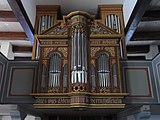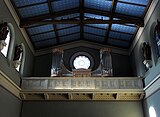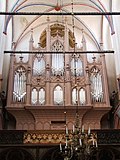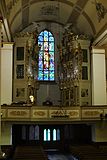Wegscheider organ workshop
The Wegscheider organ workshop in Dresden- Rähnitz is a company of the organ builder Kristian Wegscheider, which has existed since 1989 . To date, around 40 organs have been built and more than 60 restorations have been carried out.
history
The organ workshop was founded in Dresden in 1989 as a private company. Kristian Wegscheider, who was born in Ahrenshoop in 1954 , previously worked in a Barther cabinet maker after completing high school and military service in the NVA , and from 1975 to 1978 he completed vocational training as an organ builder in Dresden at the Jehmlich company . From 1976 to 1980 he took a distance learning course on the restoration of musical instruments at technical schools in Berlin and Leipzig . At the Jehmlich company he was organ restorer and head of the restoration department. In 1987 Wegscheider applied to the GDR authorities for approval to open his own workshop, which he opened in the spring of 1989 in Dresden's Alaunstrasse with initially two employees. Part of the time in between he bridged in the restoration workshop in the musical instrument museum of the University of Leipzig. The official start of work in his workshop was June 1, 1989.
In December 1990, Wegscheider received the master craftsman's certificate in response to a requirement from the trade office . His first order was a new building for the castle chapel of Allstedt Castle . In the summer of 1994 the workshop moved to Dresden-Hellerau . In 2007 the workshop employed ten people. The most important restorations of the Wegscheider company include the organ in the St. Nikolai Church (Stralsund) , the Stellwagen organ in Stralsund's Marienkirche , the Amalienorgel in the church Zur Happy News in Berlin-Karlshorst and the Silbermann organ in the Catholic church Hofkirche in Dresden.
Wegscheider was a staunch supporter of a replica of the former Gottfried Silbermann organ in the rebuilt Frauenkirche Dresden .
Innovations
Inspired by an organ from the American company Charles B. Fisk , Wegscheider began to execute some of his organs - including smaller instruments - in two temperaments so that they can be played either in a well-tempered Baroque or medium-tone Renaissance tuning. Since interventions in the sensitive and complicated playing structure with which Fisk enabled the change between two tunings seemed unsatisfactory, he constructed special loops and wind chests that allow the wind to flow to the pipes required for the respective tuning. This means that the stop action can be used to switch between the tunings, while the playing action is structured like a "normal" organ (with one tuning). He already provided his Opus 1 with a variable mood.
List of works
The list of new buildings is complete, the restoration a selection. The Roman number indicates the number of manuals, a capital "P" indicates an independent pedal, a lower-case "p" indicates an attached pedal and the Arabic number in the penultimate column indicates the number of sounding registers.
New buildings
| year | opus | place | building | image | Manuals | register | Remarks |
|---|---|---|---|---|---|---|---|
| 1990 | 1 | Allstedt | Castle chapel | I. | 8th | two temperatures | |
| 1992 | 7th | Dresden | Wegscheider organ workshop (loan instrument) | I. | 1 | lying positive with a register (Gedackt 8 ′) | |
| 1994 | 13 | Halle (Saale) | Church music college | I. | 2 | lying positive (Gedackt 8 ′, flute 4 ′) | |
| 1994 | 15th | Frauenstein (Ore Mountains) | museum | I. | 8th | Copy of the Bremen Silbermann positive | |
| 1995 | 17th | Frankfurt (Oder) | Güldendorf Church | I. | 8th | Copy of the Bremen Silbermann positive with an oak case | |
| 1995 | 18th | Steinwedel at Lehrte | St. Petri | II / P | 20th | New building in an old housing (17th century) using some registers by Johann Andreas Zuberbier (1769) | |
| 1995 | 21st | Dresden- Wilschdorf | Christophoruskirche | II / P | 14th | two temperatures | |
| 1996 | 23 | Cologne | University of Music, Wuppertal Department | I. | 1 | lying positive with a register (Gedackt 8 ′) | |
| 1996 | 24 | Blankenburg (Harz) | Michaelstein Monastery | I. | 1 | lying positive with a register (Gedackt 8 ′) | |
| 1996 | 27 | eat | Folkwang School | I. | 1 | lying positive with a register (Gedackt 8 ′) | |
| 1996 | 28 | Guestrow | Güstrow Cathedral , Winter Church | I / P | 15th | with timpani, glockenspiel, cymbal star, 2 cuckoo calls, drum, nightingale | |
| 1997 | 31 | Dresden | Loschwitz Church | II / P | 20th | second manual with alternating loops; Prospectus based on the non-preserved organ by Johann Christoph Leibner (1753) | |
| 1997 | 33 | Dresden | Kreuzkirche | I. | 1 | lying positive with a register (Gedackt 8 ′) | |
| 1999 | 40 | Ochsendorf (near Königslutter) | St. Stephani | I / P | 9 | ||
| 1999 | 42 | Friedersdorf (Mulde) | Evangelical village church | I / P | 15th | ||
| 2000 | 43 | Büsingen on the Upper Rhine | St. Michael | II / P | 15th | two tongue registers | |
| 2000 | 47 | Dresden | Music college | I. | 1 | lying positive with a register (Gedackt 8 ′) | |
| 2000 | 48 | Schwerin / Freiberg | Skobowsky (private) | I. | 1 | lying positive with a register | |
| 2000 | 49 | Berlin | Michaelitz (private) | I. | 1 | lying positive with a register (Gedackt 8 ′), permanent loan | |
| 2001 | 50 | Fintel | St. Anthony Church | II / P | 16 | romantic organ | |
| 2002 | 57 | Bremen | Bremen Cathedral , choir organ | I / P | 8th | ||
| 2003 | 60 | Cologne | Diakonie Michaelshoven | II / P | 28 | Organ in the Silbermann / Hildebrandt style ; 2017 sold to the Kunst Klang Church, Zurich | |
| 2004 | 62 | Reinfeld (Holstein) | Matthias Claudius Church | II / P | 21st | using the old positive case in the style of the 17th century | |
| 2005 | 66 | Spenge | St. Martin's Church | II / P | 17th | nine alternating loops, free-standing gaming table with a view of the altar | |
| 2005 | 69 | Sereetz | Little ship of Christ | I / P | 9 | ||
| 2006 | 68 | Stuttgart | Music college | II / P | 21st | ||
| 2007 | 72 | Freiburg in Breisgau | St. Ottilien | I. | 6th | “Bohemian Positive ”, in collaboration with Dalibor Michek, Studenky (Czech Republic); Rental instrument that has been offered for sale; since 2017 in Freiburg-St. Ottilien | |
| 2006-2008 | 73 | Lübeck-Travemünde | Reconciliation Church, Pomerania Center | II / P | 14th | ||
| 2008 | 74 | Rainbach im Mühlkreis (Austria) | Parish church | I / P | 9 | ||
| 2007-2008 | 75 | Sacrow (Potsdam) | Heilandskirche | II / P | 17th | with side game table | |
| 2008 | 77 | Dresden | Kreuzkirche | I. | 9 | Altar positive, mobile chest organ with 9 registers and separate sub-bass | |
| 2009 | 78 | Hafnarfjörður (Iceland) | Hafnarfjardarkirkja | II / P | 11 | with alternating loops | |
| 2008-2009 | 79 | Linz (Austria) | Minorite Church | II / P | 27 | New building behind the old housing facade | |
| 2008-2009 | 82 | Leipzig | Paulinum | I. | 7th | Positive with transposition device | |
| 2010 | 86 | Bohušov (Czech Republic) | St. Martin's Church | II / P | 16 | behind the existing organ case, free-standing console | |
| 2011 | 87 | Roggenstein (Vohenstrauß) | St. Erhard Church | II / P | 20th | ||
| 2012 | 84 | Jonkoping | Kristine Kyrka, choir organ | II / P | 24 | Upper work transposable | |
| 2012 | 91 | Ahrenshoop | Schifferkirche Ahrenshoop | I / P | 12 | free-standing gaming table, three alternating loops | |
| 2013 | 83 | Ritten - Unterinn | Catholic Church | II / P | 30th | ||
| 2013-2014 | 93 | Łódź | Filharmonia Łódzka , baroque organ | III / P | 37 | as a supplement to the symphonic organ by Rieger behind a common prospectus | |
| 2015-2016 | Ingolstadt | Münster To the Beautiful Our Lady , choir organ | III / P | 45 | Swallow's Nest Organ | ||
| 2012–2013 / 2018 | 94 | Danzig | Trinity Church | III / P | 45 | Reconstruction of the organ by Tobias Lehmann (1703) behind the preserved prospectus by Merten Friese (1618) together with Szymon Januszkiewicz in several construction phases | |
| 2019-2020 | Stralsund | St. Jakobi Church | III / P | 51 | New building behind the historic prospectus by Christian Gottlieb Richter (1732–1741) in the Baroque style by Richter and Ernst Julius Marx (1783) → organ |
Restorations (selection)
| year | opus | place | building | image | Manuals | register | Remarks |
|---|---|---|---|---|---|---|---|
| 1991 | 5 | Pokrent | Pokrent village church | I. | 7th | Restoration of the Christian Heinrich Wolfsteller organ from 1869 | |
| 1995 | 19th | Freiberg in Saxony | Jakobikirche |

|
II / P | 20th | Restoration of the organ by Gottfried Silbermann (1717) |
| 1997 | 29 | Tiefenau | Castle chapel | I. | 9 | Restoration (technical system) and reconstruction (pipework) of the organ by Gottfried Silbermann (1728?) | |
| 1997 | 30th | Biederitz | Biederitz village church |

|
II / P | 12 | Implementation and restoration of a Ladegast organ (1866) from Güstrow Cathedral |
| 1997 | 32 | Reinhardtsgrimma | Village church |

|
II / P | 20th | Restoration of the organ by Gottfried Silbermann (1731) |
| 1999-2002 | 39 | Schwerin | Schwerin, Paulskirche |
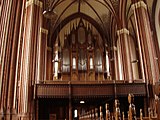
|
II / P | 31 | Restoration of the organ by Friedrich Friese III (1869) |
| 2001-2002 | 56 | Dresden | Catholic court church |

|
III / P | 47 | together with Jehmlich restoration of the organ by Gottfried Silbermann (1750–1753) |
| 2003-2006 | 64 | Stralsund | St. Nicholas Church | III / P | 56 | together with Klais restoration and reconstruction of the organ by Carl August Buchholz (1841) → Organ of the St. Nikolai Church (Stralsund) | |
| 1999-2008 | 67 | Stralsund | St. Mary's Church | III / P | 51 | Restoration of the organ by Friedrich Stellwagen (1659) → Organs of the St. Marien Church (Stralsund) | |
| 2006-2007 | 71 | Freiberg in Saxony | City Church of St. Petri |

|
II / P | 32 | together with Jehmlich restoration of the organ by Gottfried Silbermann (1733–1735) → organ |
| 2009-2010 | 80 | Berlin-Karlshorst | To the good news | II / P | 22nd | Restoration of the organ by Migendt and Marx (1755) → Organ of the parish church For the good news | |
| 2010-2011 | 88 | Zurow | Zurow village church | I / P | 9 + 1 transmission | Restoration of the organ by Christoph Erdmann Vogel (built in 1737 as a Rückpositiv for the Nikolaikirche (Wismar) ) and Friedrich Wilhelm Winzer (1861) | |
| 2010-2013 | 90 | Pr. Holland | Parish Church of St. Bartholomew | II / P | 36 | Restoration / reconstruction of the organ by Andreas Hildebrandt (1717–1719), restoration of the condition from 1719 → Organ of the Bartholomäuskirche Pasłęk |
Web links
Individual evidence
- ↑ With tears in my eyes | Edition: 4/03 | nmz - new music newspaper. Retrieved April 28, 2019 .
- ^ Orgelwerkstatt Wegscheider Dresden - Article. Retrieved April 28, 2019 .
- ↑ Organy Hildebrandta w Pasłęku - strona startowa. Retrieved August 16, 2019 .
Coordinates: 51 ° 7 ′ 10.3 " N , 13 ° 44 ′ 19.7" E








